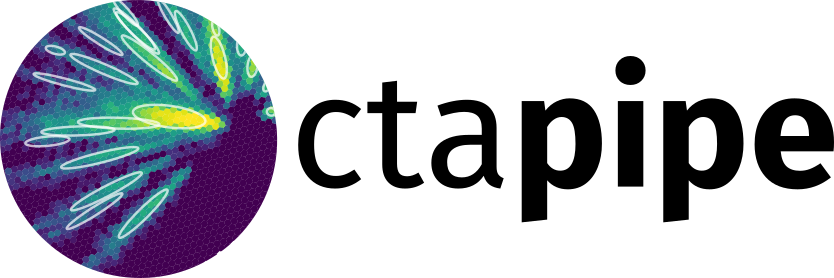"""
Algorithms for the data volume reduction.
"""
from abc import abstractmethod
import numpy as np
from ctapipe.containers import DL1CameraContainer
from ctapipe.core import TelescopeComponent
from ctapipe.core.traits import (
BoolTelescopeParameter,
ComponentName,
IntTelescopeParameter,
TelescopeParameter,
)
from ctapipe.image import TailcutsImageCleaner
from ctapipe.image.cleaning import dilate
from ctapipe.image.extractor import ImageExtractor
__all__ = ["DataVolumeReducer", "NullDataVolumeReducer", "TailCutsDataVolumeReducer"]
[docs]
class DataVolumeReducer(TelescopeComponent):
"""
Base component for data volume reducers.
"""
def __init__(self, subarray, config=None, parent=None, **kwargs):
"""
Parameters
----------
subarray: ctapipe.instrument.SubarrayDescription
Description of the subarray
config: traitlets.loader.Config
Configuration specified by config file or cmdline arguments.
Used to set traitlet values.
Set to None if no configuration to pass.
kwargs
"""
self.subarray = subarray
super().__init__(config=config, parent=parent, subarray=subarray, **kwargs)
[docs]
def __call__(self, waveforms, tel_id=None, selected_gain_channel=None):
"""
Call the relevant functions to perform data volume reduction on the
waveforms.
Parameters
----------
waveforms: ndarray
Waveforms stored in a numpy array of shape
(n_pix, n_samples).
tel_id: int
The telescope id. Required for the 'image_extractor' and
'camera.geometry' in 'TailCutsDataVolumeReducer'.
selected_gain_channel: ndarray
The channel selected in the gain selection, per pixel. Required for
the 'image_extractor' in 'TailCutsDataVolumeReducer'.
extraction.
Returns
-------
mask: array
Mask of selected pixels.
"""
mask = self.select_pixels(
waveforms, tel_id=tel_id, selected_gain_channel=selected_gain_channel
)
return mask
[docs]
@abstractmethod
def select_pixels(self, waveforms, tel_id=None, selected_gain_channel=None):
"""
Abstract method to be defined by a DataVolumeReducer subclass.
Call the relevant functions for the required pixel selection.
Parameters
----------
waveforms: ndarray
Waveforms stored in a numpy array of shape
(n_pix, n_samples).
tel_id: int
The telescope id. Required for the 'image_extractor' and
'camera.geometry' in 'TailCutsDataVolumeReducer'.
selected_gain_channel: ndarray
The channel selected in the gain selection, per pixel. Required for
the 'image_extractor' in 'TailCutsDataVolumeReducer'.
Returns
-------
mask: array
Mask of selected pixels.
"""
[docs]
class NullDataVolumeReducer(DataVolumeReducer):
"""
Perform no data volume reduction
"""
[docs]
def select_pixels(self, waveforms, tel_id=None, selected_gain_channel=None):
n_pixels = waveforms.shape[-2]
return np.ones(n_pixels, dtype=bool)
[docs]
class TailCutsDataVolumeReducer(DataVolumeReducer):
"""
Reduce the time integrated shower image in 3 Steps:
1) Select pixels with tailcuts_clean.
2) Add iteratively all pixels with Signal S >= boundary_thresh
with ctapipe module dilate until no new pixels were added.
3) Adding new pixels with dilate to get more conservative.
Attributes
----------
image_extractor_type: String
Name of the image_extractor to be used.
n_end_dilates: IntTelescopeParameter
Number of how many times to dilate at the end.
do_boundary_dilation: BoolTelescopeParameter
If set to 'False', the iteration steps in 2) are skipped and
normal TailcutCleaning is used.
"""
image_extractor_type = TelescopeParameter(
trait=ComponentName(ImageExtractor, default_value="NeighborPeakWindowSum"),
default_value="NeighborPeakWindowSum",
help="Name of the ImageExtractor subclass to be used.",
).tag(config=True)
n_end_dilates = IntTelescopeParameter(
default_value=1, help="Number of how many times to dilate at the end."
).tag(config=True)
do_boundary_dilation = BoolTelescopeParameter(
default_value=True,
help="If set to 'False', the iteration steps in 2) are skipped and"
"normal TailcutCleaning is used.",
).tag(config=True)
def __init__(
self,
subarray,
config=None,
parent=None,
cleaner=None,
image_extractor=None,
**kwargs,
):
"""
Parameters
----------
subarray: ctapipe.instrument.SubarrayDescription
Description of the subarray
config: traitlets.loader.Config
Configuration specified by config file or cmdline arguments.
Used to set traitlet values.
Set to None if no configuration to pass.
kwargs
"""
super().__init__(config=config, parent=parent, subarray=subarray, **kwargs)
if cleaner is None:
self.cleaner = TailcutsImageCleaner(parent=self, subarray=self.subarray)
else:
self.cleaner = cleaner
self.image_extractors = {}
if image_extractor is None:
for _, _, name in self.image_extractor_type:
self.image_extractors[name] = ImageExtractor.from_name(
name, subarray=self.subarray, parent=self
)
else:
name = image_extractor.__class__.__name__
self.image_extractor_type = [("type", "*", name)]
self.image_extractors[name] = image_extractor
[docs]
def select_pixels(self, waveforms, tel_id=None, selected_gain_channel=None):
camera_geom = self.subarray.tel[tel_id].camera.geometry
# Pulse-integrate waveforms
extractor = self.image_extractors[self.image_extractor_type.tel[tel_id]]
# do not treat broken pixels in data volume reduction
broken_pixels = np.zeros(
(waveforms.shape[-3], camera_geom.n_pixels), dtype=bool
)
dl1: DL1CameraContainer = extractor(
waveforms,
tel_id=tel_id,
selected_gain_channel=selected_gain_channel,
broken_pixels=broken_pixels,
)
# 1) Step: TailcutCleaning at first
mask = self.cleaner(tel_id, dl1.image)
pixels_above_boundary_thresh = (
dl1.image >= self.cleaner.boundary_threshold_pe.tel[tel_id]
)
mask_in_loop = np.array([])
# 2) Step: Add iteratively all pixels with Signal
# S > boundary_thresh with ctapipe module
# 'dilate' until no new pixels were added.
while (
not np.array_equal(mask, mask_in_loop)
and self.do_boundary_dilation.tel[tel_id]
):
mask_in_loop = mask
mask = dilate(camera_geom, mask) & pixels_above_boundary_thresh
# 3) Step: Adding Pixels with 'dilate' to get more conservative.
for _ in range(self.n_end_dilates.tel[tel_id]):
mask = dilate(camera_geom, mask)
return mask

